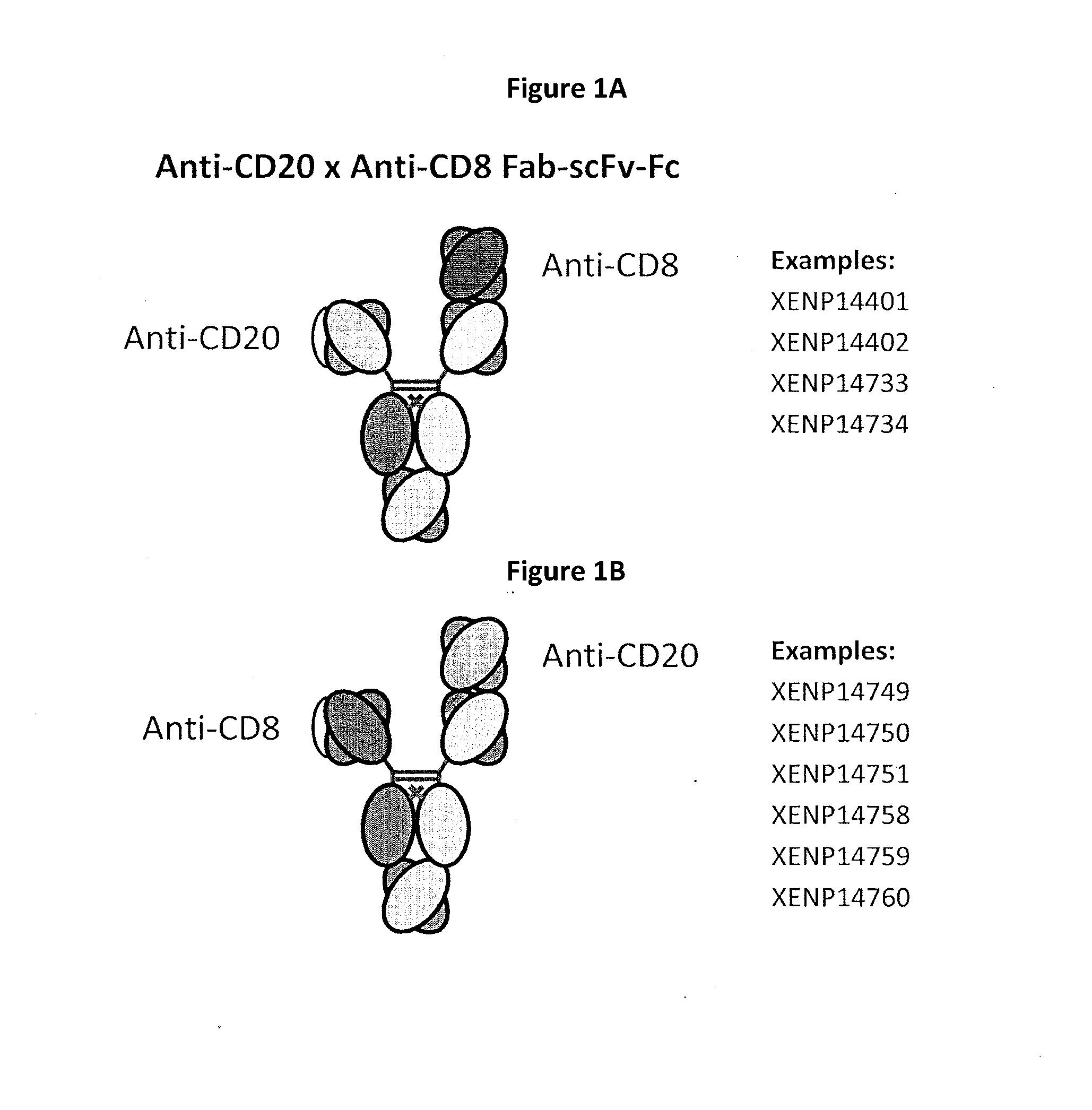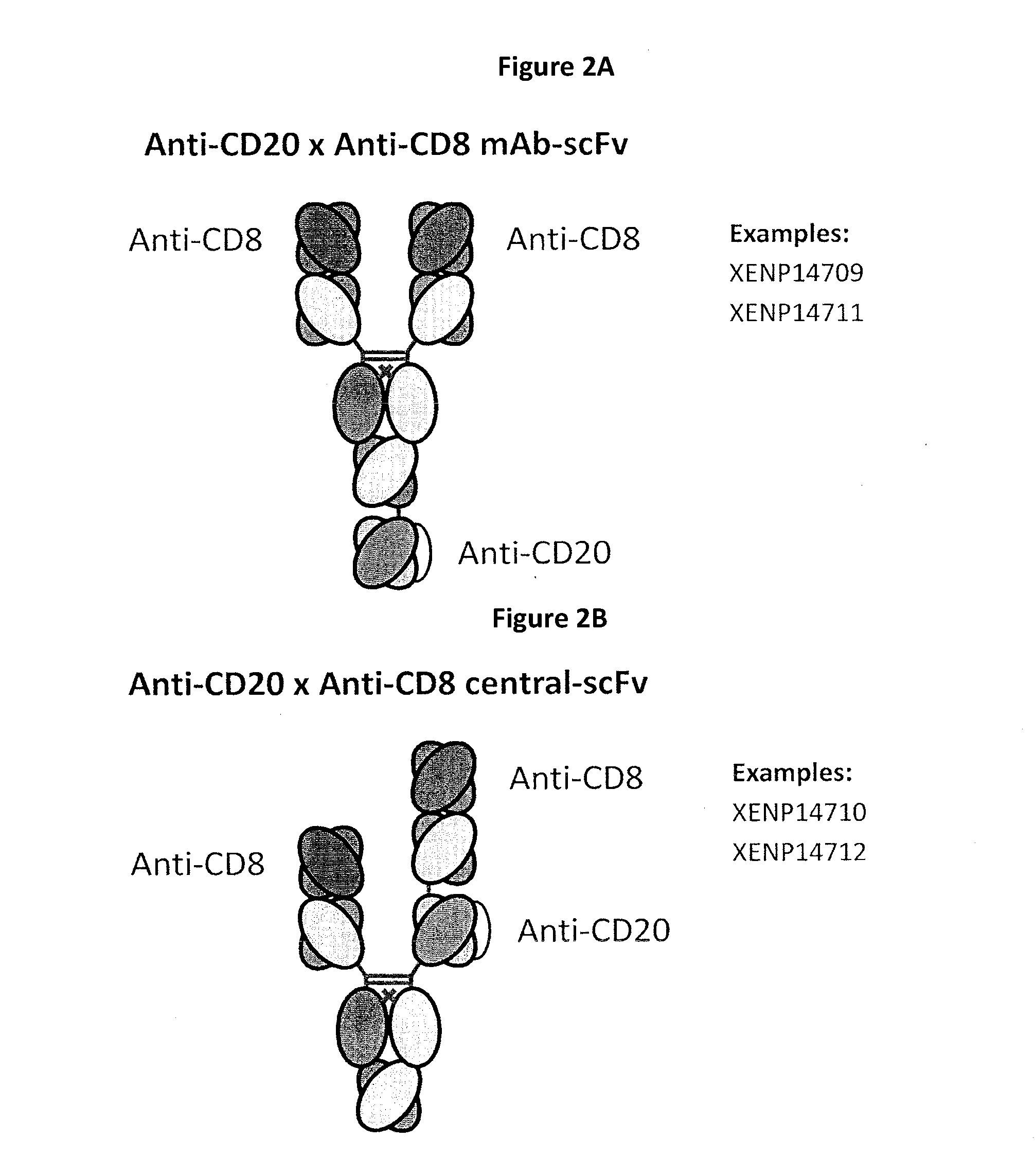Heterodimeric antibodies including binding to cd8
a technology of cd8 and cd8, which is applied in the direction of peptides, drug compositions, and fused cells, can solve the problems of affecting the production and stability of antibody fragments, the constant region of the antibody with its associated functional properties, and the inability to guarantee the stability of the antibody
- Summary
- Abstract
- Description
- Claims
- Application Information
AI Technical Summary
Benefits of technology
Problems solved by technology
Method used
Image
Examples
example 1
Design of Non-Native Charge Substitutions to Reduce pI
[0388]Antibody constant chains were modified with lower pI by engineering substitutions in the constant domains. Reduced pI can be engineered by making substitutions of basic amino acids (K or R) to acidic amino acids (D or E), which result in the largest decrease in pI. Mutations of basic amino acids to neutral amino acids and neutral amino acids to acidic amino acids will also result in a decrease in pI. A list of amino acid pK values can be found in Table 1 of Bjellqvist et al., 1994, Electrophoresis 15:529-539.
[0389]We chose to explore substitutions in the antibody CH1 (Cγ1) and CL (Ckappa or CK) regions (sequences are shown in FIG. 13of U.S. Ser. No. 14 / 216,705, incorporated by reference) because, unlike the Fc region, they do not interact with native ligands that impact the antibody's pharmacological properties. In deciding which positions to mutate, the surrounding environment and number of contacts the WT amino acid makes...
example 2
Engineering Approaches to Constant Region pI Engineering
[0395]Reduction in the pI of a protein or antibody can be carried out using a variety of approaches. At the most basic level, residues with high pKa's (lysine, arginine, and to some extent histidine) are replaced with neutral or negative residues, and / or neutral residues are replaced with low pKa residues (aspartic acid and glutamic acid). The particular replacements may depend on a variety of factors, including location in the structure, role in function, and immunogenicity.
[0396]Because immunogenicity is a concern, efforts can be made to minimize the risk that a substitution that lowers the pI will elicit immunogenicity. One way to minimize risk is to minimize the mutational load of the variants, i.e. to reduce the pI with the fewest number of mutations. Charge swapping mutations, where a K, R, or H is replaced with a D or E, have the greatest impact on reducing pI, and so these substitutions are preferred. Another approach t...
example 3
Isotypic Light Chain Constant Region Variants
[0400]Homology between CK and Cλ is not as high as between the IgG subclasses, however the sequence and structural homology that exists was still used to guide substitutions to create an isotypic low-pI light chain constant region. In FIG. 56 of U.S. Ser. No. 14 / 216,705, incorporated by reference, positions with residues contributing to a higher pI (K, R, and H) or lower pI (D and E) are highlighted in bold. Gray indicates lysine, arginines, and histidines that may be substituted, preferably with aspartic or glutatmic acids, to lower the isoelectric point. These variants, alone or in any combination, can independently and optionally be combined with all other heavy chain variants in scaffolds that have at least one light chain.
PUM
| Property | Measurement | Unit |
|---|---|---|
| molecular weight | aaaaa | aaaaa |
| molecular weight | aaaaa | aaaaa |
| pH | aaaaa | aaaaa |
Abstract
Description
Claims
Application Information
 Login to View More
Login to View More - R&D
- Intellectual Property
- Life Sciences
- Materials
- Tech Scout
- Unparalleled Data Quality
- Higher Quality Content
- 60% Fewer Hallucinations
Browse by: Latest US Patents, China's latest patents, Technical Efficacy Thesaurus, Application Domain, Technology Topic, Popular Technical Reports.
© 2025 PatSnap. All rights reserved.Legal|Privacy policy|Modern Slavery Act Transparency Statement|Sitemap|About US| Contact US: help@patsnap.com



